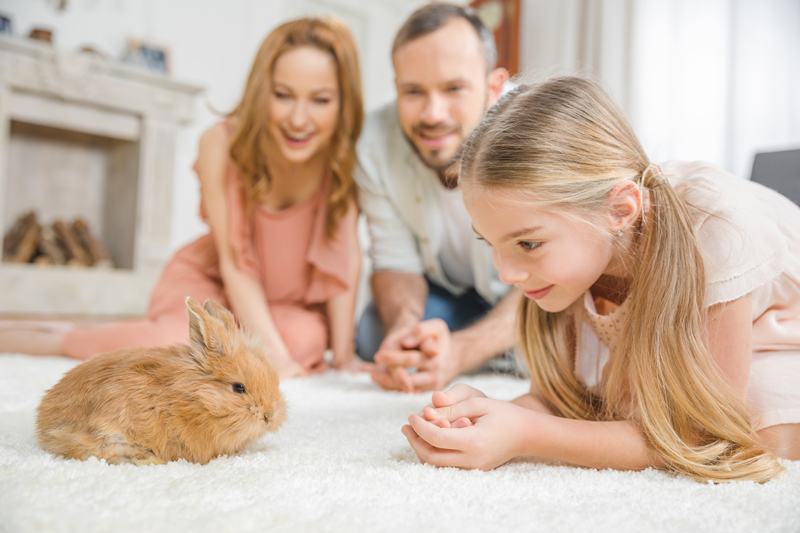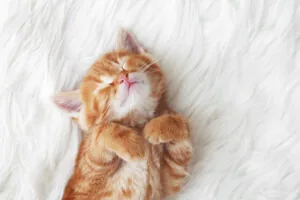Rabbit Care 101
Housing
- Indoor housing is essential. Domestic rabbits can die from heart attacks at the very approach of a predator. Other outdoor concerns: fleas (anemia, West Nile virus), ticks, and fly strike.
- Wire flooring can cause and/or exacerbate hock problems, which can become serious enough to require amputation. Use ordinary cat or dog cages, or cover wire flooring with sections of newspaper (can be messy if bunny digs) or plain, brown corrugated cardboard. If dog cages are used, check to be sure the spacing between the cage wires is small enough to prevent a rabbit’s head or limbs from getting stuck.
- Place rabbits away from extreme heat. Avoid placing rabbits on top tier of cages if possible – especially in summer.
- Travel carrier: to take your rabbit home or to and from the veterinarian, you’ll need a hard plastic animal carrier, lined on the bottom with something soft and absorbent like a towel or blanket.
- Toys: toys provide mental and physical stimulation to keep rabbits from getting bored, overweight and depressed. Good rabbit toys include paper bags and cardboard boxes for crawling into, scratching and chewing, small balls or cat toys that can be tossed around and kitty condos for climbing.
- Play and exercise area: rabbits need four to five hours each day outside of their crate to exercise, play and socialize. For that, you’ll need a fairly large, rabbit-proof space. Ideally, this area is carpeted to provide traction as the rabbit runs and jumps, as they can slip or slide and injure themselves on a hardwood or tile surface.
Litterbox
The most important thing you’ll need is a litter box, or several- the larger the better. Most rabbits prefer to always use the bathroom in the same spot and are very clean creatures by nature, making it very easy to litterbox train them. Some people like to line the box with a plastic liner for ease of cleaning, but this is not strictly necessary. You can line the box with newspaper and then place a layer of litter on top- Yesterday’s News, Carefresh, and Feline Pine (unscented) are all excellent brands. Just make sure to avoid clay litters, wood chips, or anything scented. Place a pile of hay on top of the layer of litter- this will encourage them to sit in the box so that using it becomes a habit. Change the litter and clean the box with a solution of white vinegar diluted 1:20 with water at least twice weekly- more often if you use a smaller box or have multiple rabbits. You may also want to consider placing a few additional boxes in any other rooms the rabbit has regular access to.
Hide Box
Your rabbit will appreciate having a hide box inside the pen. It should have multiple entry/exit holes, be large enough to stretch out in while hiding underneath, and be sturdy enough to sit on top of for those interested in keeping up surveillance.
Dishes
For water, you will want to purchase a solid, heavy ceramic crock that the rabbit cannot tip over. These are easier to keep clean than sipper bottles and rabbits tend to drink more when offered water in this manner. Change the water at least once daily, more often if it becomes soiled.
Feeding
Your rabbit’s diet is very influential on his well-being. Below is an overview of what to feed him/her, in order of quantity:
- Unlimited Grass Hay: Select Orchard grass or Timothy hay. Hay is integral to a rabbit’s digestive and dental health and makes up the bulk of his diet. Make fresh hay available to your rabbit at all times. The hay sold in pet supply stores tends to be poor quality, and is very expensive. Rabbits enjoy long strands of fresh, fragrant hay. Do not get alfalfa hay unless you have babies or an older rabbit who can’t keep his weight up. Alfalfa hay has too many calories and too much calcium to be anything but a treat for most rabbits. Oat hay is also a treat — the seeds are high in calories.
- Fresh Vegetables:A salad of at least 3 dark leafy greens twice a day. Minimum of 2 cups of fresh veggies per 5 lbs. of body weight per day. Introduce new vegetables to your rabbit in small quantities and one at a time, as rabbits have different preferences and sensitivities to various vegetables. If you notice softening of the droppings or diarrhea (an emergency in rabbits) following a certain vegetable, withdraw it from the diet.
- Timothy Pellets for Adult Rabbits: Alfalfa pellets are for babies and aged bunnies who can’t keep their weight up. Just look at the first ingredient on the packaging to see whether it’s timothy or alfalfa. Do not get the food advertised for rabbits with the extra nuts, seeds, yogurt, dried fruit, and such — it is high calorie junk food. You won’t need a big bag, either, unless you’ve got babies, because adults get only an 1/8 cup or so, a couple of times a day.
- Fresh Water: Rabbits can dehydrate quickly, so make sure they always have clean water available. Clean the bowl daily, as mold can kill a bunny.
Handling
Most rabbits do not enjoy being picked up and held. Being restrained may trigger the same feelings as when they are captured by a predator, and being picked up off the ground may feel comparable to being snatched by a bird of prey. Often rabbits will struggle, kick, and thrash when picked up. Be prepared for this- dropping your rabbit can cause serious, even fatal, injury to their delicate spine. Make sure you understand proper handling techniques before you attempt to lift your rabbit for the first time. With patience and practice, most rabbits can learn to (reluctantly) accept being held.
Grooming
Rabbits are excellent at grooming themselves- the way they see it, it is essential to be clean and odor-free in order to avoid detection by predators. You should NEVER give your rabbit a bath- immersion in water can cause them to go into shock. If there is urine or fecal matter adhered to their rear end, you can spot-clean the area with a gentle fragrance-free shampoo, such as oatmeal shampoo. Rabbits also shed seasonally. Ingesting too much hair during self-grooming combined with an inability to vomit can lead to hairballs, so it is highly recommended to brush your rabbit at least once daily while they are shedding. Flea combs and slicker brushes work well. Rabbits have thin, sensitive skin, so monitor them for discomfort, especially when using brushes with firmer bristles or when combing out mats and tangles. For particularly bad mats, it is a better idea to set up an appointment to have a vet tech do a professional shave.
Nails should also be kept trimmed short- long nails can get snagged on something and ripped out, or may cause the rabbit to place awkward pressure on their sensitive hocks. If you are nervous about handling your rabbit or trimming the nails, most veterinarians will perform pedicures at a nominal fee as long as you are up to date with your annual exams.
Spay/Neuter
There are several reasons why even solitary rabbits should get fixed. One of these reasons is health. Unspayed females, for example, have a very high chance of developing reproductive organ cancers within a few years of life. Another reason is behavior. Sexual maturity, which is reached at 3 to 8 months, can lead to many unwanted behaviors, such as loss of litter box habits, urine spraying and marking, mounting, aggression, and excessive chewing. Neutered bunnies are much less likely to exhibit these behaviors and are calmer, happier, cleaner, and healthier.
Veterinary Care
Not all veterinarians are knowledgeable about rabbit care, so you should make an effort to find the right doctor for your bunny now, before he gets sick. There are no recommended vaccines for rabbits in North America, but pet rabbits should be seen by a veterinarian at least once a year for a checkup.
Share This Post
Recent Posts
About Shallowford Animal Hospital
Shallowford Animal Hospital and The Pet Spa at Shallowford are dedicated to the exceptional, compassionate care your pet deserves. Pets hold a very special place in our families, and we treat yours like our own.




